
.
ChristoSophia in Poros

In May, 2004, we embarked on a “mythic quest” of Greece with eight fellow pilgrims, several of whom were members of our ChristoSophia Community. Our purpose was to explore the spiritual heritage of Greece, which forms the foundation of our Western culture, by pilgrimage to sacred sites that span the ages of the Greek mythological imagination, from pagan antiquity through Eastern Orthodox Christianity. In particular, we were searching for the Divine Feminine in her multifaceted manifestations within the Greek psyche—from her roots in the pagan goddess figures of ancient Greece that blossomed into the images of the Divine Feminine in Orthodox iconography. For Sophia—as the archetypal Divine Feminine in Christian tradition—has always been easier to find in the Eastern than in the Western Church, which repressed the feminine elements more vigorously. For example, in the Divine Liturgy of the Eastern Orthodox Church, the priest explicitly exclaims, “Sophia, Wisdom of the Highest!” as he makes the sign of the Cross over the altar with the Gospels.
We discovered Sophia in one of her guises in Eastern Orthodoxy on our very first stop in the Greek isles, which was Poros.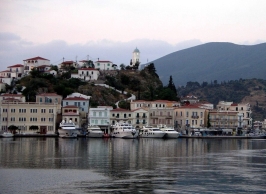 This island, separated from the Peloponnese of mainland Greece by a narrow strait, is a busy tourist destination. Leaving behind the noise and activity of the dockside shops and tavernas, we hired a taxi to drive us up the steep winding roads to the quiet solitude of the Monastery of Poros. Upon arrival we were transfixed by the sight of the beautiful whitewashed buildings with red tile roofs, surrounded by dark green cypress trees, and the shimmering blue sea that could be seen beyond the monastery walls, all illumined in the sunlight.
This island, separated from the Peloponnese of mainland Greece by a narrow strait, is a busy tourist destination. Leaving behind the noise and activity of the dockside shops and tavernas, we hired a taxi to drive us up the steep winding roads to the quiet solitude of the Monastery of Poros. Upon arrival we were transfixed by the sight of the beautiful whitewashed buildings with red tile roofs, surrounded by dark green cypress trees, and the shimmering blue sea that could be seen beyond the monastery walls, all illumined in the sunlight.
Already recognizing the numinous quality of this sacred place, we walked through the gate and entered the monastery.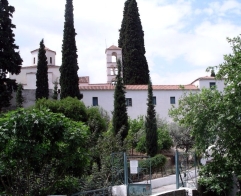 The first thing that we saw was an icon of the Mother and Child, seated within a Chalice, from which streams of water flowed into a rectangular pool beneath. This was a startling synchronicity, as the meditation of our ChristoSophia Community prior to embarking on this pilgrimage had focused on the theme of this icon, “The Life-giving Source.” We felt that Sophia had truly led us to this place and was giving us her blessing to initiate our journey.
The first thing that we saw was an icon of the Mother and Child, seated within a Chalice, from which streams of water flowed into a rectangular pool beneath. This was a startling synchronicity, as the meditation of our ChristoSophia Community prior to embarking on this pilgrimage had focused on the theme of this icon, “The Life-giving Source.” We felt that Sophia had truly led us to this place and was giving us her blessing to initiate our journey.
We later found out that the monastery had been built by a bishop from Athens in the 1700s who was cured by the holy water from a spring in the area. The “spring of the immortal water” is still within the walls of the monastery, to which it gives its name: “The Holy Monastery of the Life-giving Source (Zoodochos Pighi.)” 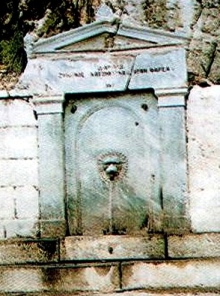 The icon that we encountered when we entered the monastery is one of many variants that we subsequently saw throughout Greece that represent the mystery of the “immortal” or “living water.” This is the spiritual water that Jesus referred to when he spoke to the Samaritan woman at the well:
The icon that we encountered when we entered the monastery is one of many variants that we subsequently saw throughout Greece that represent the mystery of the “immortal” or “living water.” This is the spiritual water that Jesus referred to when he spoke to the Samaritan woman at the well:
"Everyone who drinks of this water will thirst again, but whoever drinks of the water that I shall give him will never thirst; the water that I shall give him will become in him a spring of water welling up to eternal life."
(John 4: 13-14)
The Chalice, the wellspring of the “living water” that Christ offered the Samaritan woman (John 4:10), is a form of the archetypal Grail. Throughout diverse traditions the Grail represents the feminine side of God; the cauldron of the Goddess in pagan ritual, the cup borne by the Maidens of the Well in medieval folklore, and the chalice that upholds the Mother of God in Christian iconography, all attest to the archetypal association of the Grail with the Divine Feminine. The “water of life” contained in the Grail is also a deeply feminine symbol. For the Feminine is the Source of Life: just as all of life began in the waters of the maternal sea, so all human life begins within the waters of the mother's womb. In Christian symbolism, the Virgin Mary - Mother of God – is often associated with water; her very name in Latin, “Maria,” means “the sea.” And the connection of Sophia with this icon is made explicit in the Biblical passage, “Wisdom (Sophia) is a fountain of life…” (Proverbs 16: 22)
Ultimately the icon of the Life-giving Source represents ChristoSophia in its union of the feminine and masculine divine images of Mary and Christ. Both the Virgin Mary, in her Sophianic aspect as Mother Goddess, and Jesus Christ offer the gift of life. Sophia's statement, “he who finds me finds life” (Proverbs 8:35) is echoed in the claim of Jesus Christ: “I came that they may have life, and have it abundantly.” (John 10:10) Sophia and Jesus Christ symbolize the two different manifestations of life that are expressed in the Greek words zoe and bios. As Anne Baring and Jules Cashford explain:
"Zoe and bios (are) the embodiment of two dimensions co-existing in life. Zoe is eternal and infinite life; bios is finite and individual life. Zoe is infinite being: bios is the living and dying manifestation of the eternal world in time."(1)
Mary/Sophia as the archetypal Mother Goddess symbolizes zoe – the Life that is the Source of all Being, while Christ as the archetypal Son of the Goddess represents bios – incarnate life that undergoes the cyclical process of birth and death. Through the resurrection of Christ, the temporal life of the individual is united with the Eternal Life of the Spirit; bios and zoe are joined; Christ and Sophia reign together. This is the Mystery that is conveyed by the icon of the Life-giving Source.
When we drink from the “living water” of the Life-giving Source, our inner being opens to the awareness of our true nature as the eternal Self.
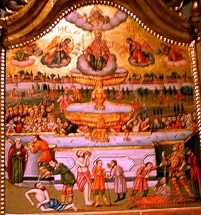 As the pagan Greeks taught, when we incarnate on Earth we drink from the Well of Forgetting and lose the memory of our True Self as we identify ourselves with the limited body/ego. Spiritual illumination occurs when we drink from the Well of Recollection and remember who we truly are – the divine Self – and where we came from – the heavenly realms of the Spirit. Within Christianity this spiritual truth is expressed as the “living water” offered by ChristoSophia that makes us aware of our simultaneous existence as ego and divine Self, existing in both the earthly and the heavenly realms. This awareness leads us to the transformed consciousness of the spiritualized human being. The Jungian analyst Edward Edinger, in his discussion of the archetypal symbolism of Greek mythology in The Eternal Drama, summarizes this theme:
As the pagan Greeks taught, when we incarnate on Earth we drink from the Well of Forgetting and lose the memory of our True Self as we identify ourselves with the limited body/ego. Spiritual illumination occurs when we drink from the Well of Recollection and remember who we truly are – the divine Self – and where we came from – the heavenly realms of the Spirit. Within Christianity this spiritual truth is expressed as the “living water” offered by ChristoSophia that makes us aware of our simultaneous existence as ego and divine Self, existing in both the earthly and the heavenly realms. This awareness leads us to the transformed consciousness of the spiritualized human being. The Jungian analyst Edward Edinger, in his discussion of the archetypal symbolism of Greek mythology in The Eternal Drama, summarizes this theme: "The message is, I drink the water in the Underworld and I inherit eternity as a result. The image also appears in alchemical symbolism as the water of life, the aqua vitae or aqua permanens. It is an image of the Self as the center of the psyche that conveys meanings beyond time and space, and so is eternal…The image comes up again in Jesus' encounter with the Samaritan woman."(2)
It is from the Well of ChristoSophia that we draw the nourishment from our deepest Self – the Divine within us – that gives us “abundance of life.” This is the sustenance of our true nature that overcomes the sense of separation that is maintained by willful striving, and leads us to the willing surrender that allows us to flow within the Oneness of Being. This is the Source that transcends the opposites of temporal and eternal, ego and Self, the light and dark aspects of life. The “water of life” that comes from this Source is a bitter-sweet draught that contains all of life's joy and pain, for this is the richness of Life. We are only fully alive when we reject nothing of what life offers; then we are able to live in the present moment and appreciate life in its entirety. Thus when we drink deeply of the “living water”, we fully experience the happiness and sorrow in our own life and feel our connection to all other beings in their pain as well as their joy.
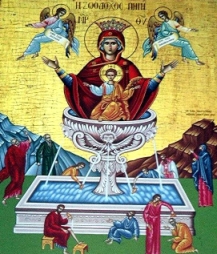
Whereas drinking the water of the Life-giving Source bestows upon us the gift of illumined consciousness, immersion in the Fountain itself unites us with the Wellspring of Life. This is the spiritual baptism that represents mystical union with the Source of Life, the Ground of Being, or God. Carl Jung refers to the alchemical symbolism of this image when he says:
"The perpetual, permanent…divine water…was also the bath of regeneration, the spring rain which brings forth vegetation."(3)
Through immersion in this bath we experience “regeneration,” the greening of our souls that results from union with the Divine at the center of all creation. Baptism in the “living water” signifies the attainment of unitive consciousness, an experience of oneness with the divine Spirit that pervades all of life. The gnostic Gospel of Philip refers to this experience:
"There are some who go into the water, and when they emerge, they recognize the Presence in everything… What we call the world is not the real world; But if we could see it with the eyes of the Being who infuses it, we would see it as incorruptible and immortal."(4)
In the numinous atmosphere of the monastery at Poros it is very easy to recognize the divine Presence in every aspect of this sacred site, from the sanctity within the small chapel at its center to the beauty of its natural surroundings.
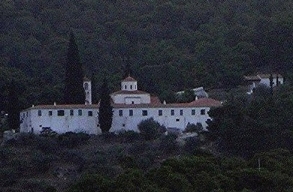 The icon of the Life-giving Source truly expresses the spiritual essence of this holy place to which it gives its name. It is the gift of this transformed consciousness that we receive from the “immortal Spring” at Poros that we take with us when we return from our pilgrimage to our daily lives.
Then we drink of the “living water” in a continual act of recollection, and hear the message contained within the icon:
The icon of the Life-giving Source truly expresses the spiritual essence of this holy place to which it gives its name. It is the gift of this transformed consciousness that we receive from the “immortal Spring” at Poros that we take with us when we return from our pilgrimage to our daily lives.
Then we drink of the “living water” in a continual act of recollection, and hear the message contained within the icon: Remember:
Who you are…
Where you came from…
Remember that everything is God.
NOTES
1. Anne Baring and Jules Cashford, The Myth of the Goddess: Evolution of an Image (London: Arkana, 1993), p. 148.
2. Edward Edinger, The Eternal Drama (Boston: Shambhala, 1994), p. 161.
3. Carl Gustav Jung, Mysterium Coniunctionis (Princeton, NJ: Princeton University Press, 1970), p. 484.
4. Jean-Yves LeLoup, The Gospel of Philip (Rochester, Vermont: Inner Traditions, 2004), p. 129.
Back to top
Ultimately the icon of the Life –giving Source represents ChristoSophia in its union of the feminine and masculine divine images of Mary and Christ. Both the Virgin Mary and Jesus Christ offer the gift of life.
It is from the Well of ChristoSophia that we draw the nourishment from our deepest Self – the Divine within us – that gives us “abundance of life.”
Baptism in the “living water” signifies the attainment of unitive consciousness, an experience of oneness with the divine Spirit that pervades all of life.
Through the resurrection of Christ, the temporal life of the individual is united with the Eternal Life of the Spirit; Christ and Sophia reign together. This is the Mystery that is conveyed by the icon of the Life-giving Source.